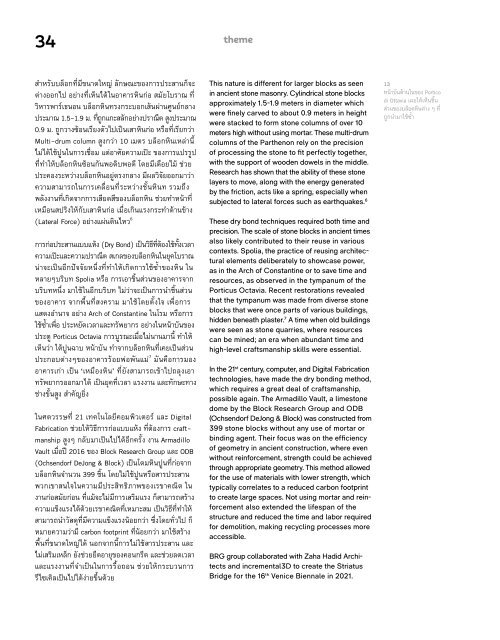ASA Journal 16/2023
Create successful ePaper yourself
Turn your PDF publications into a flip-book with our unique Google optimized e-Paper software.
34<br />
theme<br />
สำาหรับบล็อกที่มีขนาดใหญ่ ลักษณะของการประสานก็จะ<br />
ต่างออกไป อย่างที่เห็นได้ในอาคารหินก่อ สมัยโบราณ ที่<br />
วิหารพาร์เธนอน บล็อกหินทรงกระบอกเส้นผ่านศูนย์กลาง<br />
ประมาณ 1.5-1.9 ม. ที่ถูกแกะสลักอย่างปราณีต สูงประมาณ<br />
0.9 ม. ถูกวางซ้อนเรียงตัวไปเป็นเสาหินก่อ หรือที่เรียกว่า<br />
Multi-drum column สูงกว่า 10 เมตร บล็อกหินเหล่านี้<br />
ไม่ได้ใช้ปูนในการเชื่อม แต่อาศัยความเป๊ะ ของการแปรรูป<br />
ที่ทำาให้บล็อกหินซ้อนกันพอดิบพอดี โดยมีเดือยไม้ ช่วย<br />
ประคองระหว่างบล็อกหินอยู่ตรงกลาง มีผลวิจัยออกมาว่า<br />
ความสามารถในการเคลื่อนที่ระหว่างชั้นหินท รวมถึง<br />
พลังงานที่เกิดจากการเสียดสีของบล็อกหิน ช่วยทำาหน้าที่<br />
เหมือนสปริงให้กับเสาหินก่อ เมื่อเกินแรงกระทำาด้านข้าง<br />
(Lateral Force) อย่างแผ่นดินไหว 6<br />
การก่อประสานแบบแห้ง (Dry Bond) เป็นวิธีที่ต้องใช้ทั้งเวลา<br />
ความเป๊ะและความปราณีต สเกลของบล็อกหินในยุคโบราณ<br />
น่าจะเป็นอีกปัจจัยหนึ่งที่ทำาให้เกิดการใช้ซ้ำาของหิน ใน<br />
หลายๆบริบท Spolia หรือ การเอาชิ้นส่วนของอาคารจาก<br />
บริบทหนึ่ง มาใช้ในอีกบริบท ไม่ว่าจะเป็นการนำาชิ้นส่วน<br />
ของอาคาร จากพื้นที่สงคราม มาใช้โดยตั้งใจ เพื่อการ<br />
แสดงอำานาจ อย่าง Arch of Constantine ในโรม หรือการ<br />
ใช้ซ้ำาเพื่อ ประหยัดเวลาและทรัพยากร อย่างในหน้าบันของ<br />
ประตู Porticus Octavia การบูรณะเมื่อไม่นานมานี้ ทำาให้<br />
เห็นว่า ใต้ปูนฉาบ หน้าบัน ทำาจากบล็อกหินที่เคยเป็นส่วน<br />
ประกอบต่างๆของอาคารร้อยพ่อพันแม่7 มันคือการมอง<br />
อาคารเก่า เป็น ‘เหมืองหิน’ ที่ยังสามารถเข้าไปถลุงเอา<br />
ทรัพยากรออกมาได้ เป็นยุคที่เวลา แรงงาน และทักษะทาง<br />
ช่างขั้นสูง สำาคัญยิ่ง<br />
ในศตวรรษที่ 21 เทคโนโลยีคอมพิวเตอร์ และ Digital<br />
Fabrication ช่วยให้วิธีการก่อแบบแห้ง ที่ต้องการ craftmanship<br />
สูงๆ กลับมาเป็นไปได้อีกครั้ง งาน Armadillo<br />
Vault เมื่อปี 20<strong>16</strong> ของ Block Research Group และ ODB<br />
(Ochsendorf DeJong & Block) เป็นโดมหินปูนที่ก่อจาก<br />
บล็อกหินจำานวน 399 ชิ้น โดยไม่ใช้ปูนหรือสารประสาน<br />
พวกเขาสนใจในความมีประสิทธิภาพของเรขาคณิต ใน<br />
งานก่อสมัยก่อน ที่แม้จะไม่มีการเสริมแรง ก็สามารถสร้าง<br />
ความแข็งแรงได้ด้วยเรขาคณิตที่เหมาะสม เป็นวิธีที่ทำาให้<br />
สามารถนำาวัสดุที่มีความแข็งแรงน้อยกว่า ซึ่งโดยทั่วไป ก็<br />
หมายความว่ามี carbon footprint ที่น้อยกว่า มาใช้สร้าง<br />
พื้นที่ขนาดใหญ่ได้ นอกจากนี้การไม่ใช้สารประสาน และ<br />
ไม่เสริมเหล็ก ยังช่วยยืดอายุของคอนกรีต และช่วยลดเวลา<br />
และแรงงานที่จำาเป็นในการรื้อถอน ช่วยให้กระบวนการ<br />
รีไซเคิลเป็นไปได้ง่ายขึ้นด้วย<br />
This nature is different for larger blocks as seen<br />
in ancient stone masonry. Cylindrical stone blocks<br />
approximately 1.5-1.9 meters in diameter which<br />
were finely carved to about 0.9 meters in height<br />
were stacked to form stone columns of over 10<br />
meters high without using mortar. These multi-drum<br />
columns of the Parthenon rely on the precision<br />
of processing the stone to fit perfectly together,<br />
with the support of wooden dowels in the middle.<br />
Research has shown that the ability of these stone<br />
layers to move, along with the energy generated<br />
by the friction, acts like a spring, especially when<br />
subjected to lateral forces such as earthquakes. 6<br />
These dry bond techniques required both time and<br />
precision. The scale of stone blocks in ancient times<br />
also likely contributed to their reuse in various<br />
contexts. Spolia, the practice of reusing architectural<br />
elements deliberately to showcase power,<br />
as in the Arch of Constantine or to save time and<br />
resources, as observed in the tympanum of the<br />
Porticus Octavia. Recent restorations revealed<br />
that the tympanum was made from diverse stone<br />
blocks that were once parts of various buildings,<br />
hidden beneath plaster. 7 A time when old buildings<br />
were seen as stone quarries, where resources<br />
can be mined; an era when abundant time and<br />
high-level craftsmanship skills were essential.<br />
In the 21 st century, computer, and Digital Fabrication<br />
technologies, have made the dry bonding method,<br />
which requires a great deal of craftsmanship,<br />
possible again. The Armadillo Vault, a limestone<br />
dome by the Block Research Group and ODB<br />
(Ochsendorf DeJong & Block) was constructed from<br />
399 stone blocks without any use of mortar or<br />
binding agent. Their focus was on the efficiency<br />
of geometry in ancient construction, where even<br />
without reinforcement, strength could be achieved<br />
through appropriate geometry. This method allowed<br />
for the use of materials with lower strength, which<br />
typically correlates to a reduced carbon footprint<br />
to create large spaces. Not using mortar and reinforcement<br />
also extended the lifespan of the<br />
structure and reduced the time and labor required<br />
for demolition, making recycling processes more<br />
accessible.<br />
BRG group collaborated with Zaha Hadid Architects<br />
and incremental3D to create the Striatus<br />
Bridge for the <strong>16</strong> th Venice Biennale in 2021.<br />
13<br />
หน้าบันด้านในของ Portico<br />
di Ottavia เผยให้เห็นชิ้น<br />
ส่วนของบล๊อคหินต่าง ๆ ที่<br />
ถูกนำามาใช้ซ้ำา

















